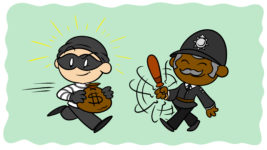Not all works of fiction rely on a cast made up exclusively of deep, complex, and inscrutable characters. Some need a character that the audience can inhabit or possess; a platform for the reader to survey the world from and a mouthpiece for their own questions and thoughts.
Such ‘reader proxy’ (or, in the case of screenplays and scripts, ‘audience surrogate’) characters can work wonders, particularly in works of genre fiction, children’s lit, and YA. Think, for example, of Harry Potter in the early Harry Potter books – a fairly flat character who, like the reader, is new to the fantastic world of witchcraft and wizardry and who voices all the reader’s own awestruck thoughts and questions. Or think of Bella Swan in the Twilight books, who is such a non-character that her role as a reader proxy is probably too explicit. She is, as actress Kristen Stewart (who played Bella in the Twilight films) said, ‘a hollow placeholder for all the teenage girls in the audience to project their personalities onto.’
Or, if you spent the last paragraph scoffing, think instead of Bilbo Baggins in The Hobbit, Nick in The Great Gatsby, Sal Paradise in On the Road, and Dr. Watson in the Sherlock Holmes books. All are pointedly rather ‘ordinary,’ homely, and unremarkable individuals who act as surrogate spaces that follow the more exciting and eccentric characters around: Holmes and the various villains in the Sherlock Holmes novels; Gatsby, Tom, and Daisy in The Great Gatsby; Dean Moriarty in On the Road; and Gandalf and the dwarves in The Hobbit.
Reader proxies give the reader a voice in the story.Click To TweetThere are many good reasons to include a reader proxy character in your own fiction (as well as a few bad ones), so let’s take a tour of the benefits.
Viewpoint
One of the main benefits of including a reader proxy character in, say, a thriller or a mystery novel is the level of control it affords the writer. A reader proxy (particularly one who’s narrating) helps steer and manipulate the reader by asking leading questions and focusing in on particular avenues of investigation. A whodunnit’s revelation is often only as effective as its reader proxy.
Dr. Watson is the most obvious example of this. Flouting the third-person narrator typical of his nineteenth-century peers, Arthur Conan Doyle instead has Watson narrate his Sherlock Holmes stories. We are never allowed into Holmes’s mind and never hear his presumably elucidating narration; rather, we’re led through the mysteries and investigations by the clueless Watson. The result is that Watson’s ever-reliable confusion echoes that of the reader and thus, when Holmes finally explains his method, both Watson and the reader are filled with gratitude and satisfaction.
This is one of Doyle’s key objectives, and goes some way to explaining Holmes’s lasting appeal: throughout the stories, Doyle makes every effort to ensure that the reader admires Holmes as much as Watson does.
My friend was an enthusiastic musician, being himself not only a very capable performer but a composer of no ordinary merit. All the afternoon he sat in the stalls wrapped in the most perfect happiness, gently waving his long, thin fingers in time to the music, while his gently smiling face and his languid, dreamy eyes were as unlike those of Holmes the sleuth-hound, Holmes the relentless, keen-witted, ready-handed criminal agent, as it was possible to conceive. In his singular character the dual nature alternately asserted itself, and his extreme exactness and astuteness represented, as I have often thought, the reaction against the poetic and contemplative mood which occasionally predominated in him.
– Arthur Conan Doyle, ‘The Red-Headed League’ from The Complete Sherlock Holmes
It is not enough for Holmes to be clever and efficacious; he must also be human, sensitive, and gentle. These not-so-subtle instances of reader proxy-directed character development help build Holmes’s personality and lead readers into rooting for him, thus deepening their engagement in the story.
Engagement
Let’s look into that last point more deeply. Modern readers, spoilt as we are by Netflix, YouTube, and video games, are more fickle than ever. We don’t need an excuse to give up on books that stop being engaging for even a chapter. Establishing an engaging plot is thus more important than ever and, in certain types of fiction, reader proxy characters can be the thing that keeps your readers reading.
This is partly because reader proxy characters often perform with an insidious power. It’s not simply the case that reader proxy characters ask the reader’s questions and embody the reader’s responses; the reverse is also true. Readers become gradually conditioned to respond to narrative events in the same way as their in-narrative counterparts, blurring the lines between the worlds of the character and the reader.
By embodying the reader, reader proxies gain the ability to influence them in kind. Click To TweetConsider The Great Gatsby. To the ambivalent reader, Gatsby seems like an oddball for sure; an interesting man, certainly one to keep an eye on. It’s only when Nick (as narrator) begins analyzing and elevating Gatsby’s behavior that the reader really begins to think of Gatsby as someone extraordinary. For example, instead of simply leaving it at ‘He smiled understandingly,’ Fitzgerald has Nick write:
He smiled understandingly – much more than understandingly. It was one of those rare smiles with a quality of eternal reassurance in it, that you may come across four or five times in life. It faced – or seemed to face – the whole eternal world for an instant, and then concentrated on you with an irresistible prejudice in your favor. It understood you just as far as you wanted to be understood, believed in you as you would like to believe in yourself, and assured you that it had precisely the impression of you that, at your best, you hoped to convey.
– F. Scott Fitzgerald, The Great Gatsby
Nick’s response to Gatsby becomes our response, even though we have not ourselves experienced this startling reaction to a simple smile. Because Nick, Fitzgerald’s masterfully crafted reader proxy, feels this way, we do too, and from this point on, Gatsby becomes an almost transcendent figure.
Exposition
Beyond drawing unsuspecting readers further into your plot, reader proxy characters can be a fantastic way to avoid getting bogged down in huge chunks of exposition. This is especially true when you’re writing about fantastic places in fantasy, YA, children’s, or sci-fi fiction, where you need to somehow express a whole load of information about an unfamiliar place.
A reader proxy can ask questions about the world, giving other characters a chance to explain.Click To TweetThis is because reader proxy characters are, more often than not, also new to the fantastic worlds they arrive in, meaning that they pointedly observe the unusual things the reader would also take note of and ask the same questions the reader would ask. Think of almost any famous sci-fi or fantasy narrative: the hobbits venturing out of their comfort zone in The Lord of the Rings, Luke leaving his home planet in Star Wars, Harry leaving the muggle world in Harry Potter, James meeting the insects in James and the Giant Peach, Offred’s arrival at her new household in The Handmaid’s Tale, the Time Traveler’s arrival in the future in The Time Machine… all these narratives circumvent awkward chunks of exposition by having their reader proxy characters vicariously experience strange new worlds for the reader. Consider, for example, how H.G. Wells gets away with this big chunk of physical description in The Time Machine.
The sky was no longer blue. North-eastward it was inky black, and out of the blackness shone brightly and steadily the pale white stars. Overhead it was a deep Indian red and starless, and south-eastward it grew brighter to a glowing scarlet where, cut by the horizon, lay the huge hull of the sun, red and motionless. The rocks about me were of a harsh reddish color, and all the trace of life that I could see at first was the intensely green vegetation that covered every projecting point on their south-eastern face.
– H.G. Wells, The Time Machine
The Time Traveler, like the reader, finds himself out of space and out of time, and thus is justified in his careful account of his immediate surroundings. Wells’s proxy character here – that is, a narrative tool – justifies other aspects of his craft, allowing him to include physical details that, in a narrative without a proxy character, could be considered indulgent.
Crafting an effective reader proxy character
I’ve talked about the benefits of including a reader proxy, but the question of how to write one still remains. As with most literary mechanisms, writing a good proxy character is all about balance and restraint. Your proxy character has to be engaging enough to be sympathetic and attractive, but not so developed that the reader cannot inhabit them.
Consider Harry Potter – here we have a boy defined by vague positive qualities (determination, loyalty, bravery) and a sad background of abuse that encourages reader sympathy. He approaches other characters with an open mind until they challenge his moral compass (and morality in the Harry Potter novels is helpfully black and white) and, like the reader, he’s coming to Hogwarts and the wizarding world with no prior knowledge. Harry occupies a happy middle ground here, and is a good example of an effective, if unremarkable, reader proxy character.
On the far extreme, we have Bella from Twilight, who is basically an empty body who speaks in incredibly simple sentences and who exists purely to frame the central vampire heartthrob, Edward Cullen. She’s effective at what she does, but is too transparently a mechanism and thus falls apart at the first inspection.
On the other extreme, we have characters like Nick in The Great Gatsby, whose narration and thought processes are complex and who has multiple unique relationships with different characters in the novel, from Jordan to Tom. Now, it goes without saying that Fitzgerald is a far more accomplished and skilled writer than Stephenie Meyer, and we see this reflected in the quality of each writer’s proxy character.
Balance your reader proxy – too unique and the reader can’t inhabit them, too dull and they won’t want to.Click To TweetUnlike Bella, Nick is a fully-fledged character in his own right. It’s only in comparison to the other remarkable characters (Jordan, Daisy, Tom, Myrtle, and Gatsby are all incredibly vivid, vital characters) that Nick’s less vivacious nature comes into focus, thus inviting reader habitation. When combined with his narration, Nick’s comparative blandness (as well as the fact that Nick is, like any other effective proxy character, new to the book’s setting and social contexts) renders him a reader proxy almost by default. It is Nick, through his own introspection and, crucially, his own involvement in the plot, who shapes the reader’s initial reactions to the novel’s characters and events. Consider how Nick cements a particular image of himself and the validity of his judgements:
In my younger and more vulnerable years my father gave me some advice that I’ve been turning over in my mind ever since. ‘Whenever you feel like criticizing any one,’ he told me, ‘just remember that all the people in this world haven’t had the advantages that you’ve had.’
– F. Scott Fitzgerald, The Great Gatsby
Like Harry Potter and Luke Skywalker, Nick seems to embody certain vague positive qualities; he paints himself as honest in his judgements, decent, and is quick to defend Gatsby as a victim of Tom and Daisy’s cruel and uncaring selfishness. However, unlike Rowling and Lucas’s fantasy heroes, Nick is complex enough to be analyzed and questioned himself. His motives are murky and his moral compass can be examined (unlike Harry and Luke, who are straightforwardly anti-evil). He stands above both the adequate Harry and the sub-par Bella as an actual character, not just a device, and should be emulated. Indeed, if I could give only one line of advice, I’d say: aim for Nick, settle for Harry, avoid Bella.
Another way to write an effective proxy hero is to simply create a suitably vague but undeniably cool or otherwise admirable character who the reader feels drawn to and wants to inhabit. Video games and TV shows frequently rely on this method; take the vague, badass, decent soldiers players inhabit in any number of video games or, more specifically, Rust in the neo-noir TV show True Detective. Rust (Matthew McConaughey) is an undeniably cool, ripped, alcoholic detective who has killer cheekbones, gets in manly fistfights with his decidedly less cool partner, and spouts lines of nihilistic philosophy. His blurred motives, romantic ideologies, and hashtag-nihilism are vague enough to invite the idolatry of whole generations of edgy young men.
The underlying lesson here seems to be that your proxy reader character has to be decent; the reader has to be comfortable occupying their skin and thus should understand their motives, even if they don’t agree with their actions. Beyond that, your proxy characters should ask questions the reader is either already asking or, better, wishes they’d thought of asking (this is why Rust in True Detective works – the viewer wishes they came at life with Rust’s world-weary nihilism. It’s the same admiration we see Dr. Watson encourage for Sherlock Holmes, only reached via a different road).
What not to do
As with all powerful tools, reader proxy characters can easily be misused to the detriment of your fiction. Perhaps the most important thing to remember is that proxy characters are, by necessity, flat and rather dull. They cannot carry narratives themselves; they work only when you have a vibrant cast of other characters and a fascinating world to involve the reader in. There’s a reason why nobody’s favorite Harry Potter character is Harry Potter, why everyone remembers Darth Vader’s lines instead of Luke Skywalker’s. Imagine if Watson was the protagonist in the Sherlock Holmes books or if The Great Gatsby was actually The Mediocre Nick.
In short, the other characters and the world of your book have to be interesting enough for readers to get close to them by inhabiting your reader proxy. Harry Potter is so effective as a proxy because Hogwarts is so intriguing and is filled with strange, exciting characters – if it wasn’t, nobody would want to inhabit Harry. Similarly, people only inhabit Frodo to experience Gondor or Rohan or Fangorn Forest and to be close to Aragorn, Legolas, Gimli, Gandalf, and Boromir – it’s not because they want to be a whiny little hobbit.
A reader proxy character is only as good as the things they showcase for the reader.Click To TweetThis is partly why proxy characters tend to be used most frequently in fantasy and science fiction, which rely most heavily on vivid, exciting worlds and unusual, non-human characters. But of course, characters don’t need to be elves or aliens to be startling or unusual, as The Great Gatsby and the Sherlock Holmes stories prove.
Whether you need to better integrate big chunks of exposition, stabilize your viewpoint, manipulate your readers, or simply engage your readers in the lives of your characters and the settings they inhabit, a proxy reader character can be a great way to bring your fiction to life.
Have you used a reader proxy character before? Did we miss any particularly influential reader proxy characters? Which do you think is the most effective? Let me know in the comments. Or, for more great advice about similar topics, check out This Is The Blueprint For A Perfect Cast Of Characters, Improve Your Exposition Immediately With This One Simple Tip, and Why Writers Like You Need To Know Their Key Event From Their First Plot Point.





